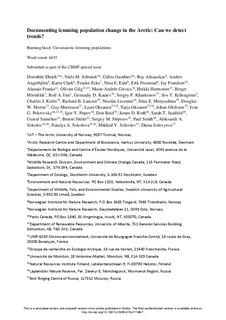| dc.contributor.author | Ehrich, Dorothee | |
| dc.contributor.author | Schmidt, Niels M. | |
| dc.contributor.author | Gauthier, Gilles | |
| dc.contributor.author | Alisauskas, Ray | |
| dc.contributor.author | Angerbjörn, Anders | |
| dc.contributor.author | Clark, Karin | |
| dc.contributor.author | Ecke, Frauke | |
| dc.contributor.author | Eide, Nina Elisabeth | |
| dc.contributor.author | Framstad, Erik | |
| dc.contributor.author | Frandsen, Jay | |
| dc.contributor.author | Franke, Alastair | |
| dc.contributor.author | Gilg, Olivier | |
| dc.contributor.author | Giroux, Marie-Andrée | |
| dc.contributor.author | Henttonen, Heikki | |
| dc.contributor.author | Hörnfeldt, Birger | |
| dc.contributor.author | Ims, Rolf Anker | |
| dc.contributor.author | Kataev, Gennadiy D. | |
| dc.contributor.author | Kharitonov, Sergey P. | |
| dc.contributor.author | Killengreen, Siw Turid | |
| dc.contributor.author | Krebs, Charles J. | |
| dc.contributor.author | Lanctot, Richard B. | |
| dc.contributor.author | Lecomte, Nicolas | |
| dc.contributor.author | Menyushina, Irina | |
| dc.contributor.author | Morris, Douglas W. | |
| dc.contributor.author | Morrisson, Guy | |
| dc.contributor.author | Oksanen, Lauri | |
| dc.contributor.author | Oksanen, Tarja Maarit | |
| dc.contributor.author | Olofsson, Johan | |
| dc.contributor.author | Pokrovsky, Ivan G. | |
| dc.contributor.author | Popov, Igor Yu. | |
| dc.contributor.author | Reid, Don | |
| dc.contributor.author | Roth, James D. | |
| dc.contributor.author | Saalfeld, Sarah T. | |
| dc.contributor.author | Samelius, Gustaf | |
| dc.contributor.author | Sittler, Benoit | |
| dc.contributor.author | Sleptsov, Sergey M. | |
| dc.contributor.author | Smith, Paul | |
| dc.contributor.author | Sokolov, Aleksandr A. | |
| dc.contributor.author | Sokolova, Natalya A. | |
| dc.contributor.author | Soloviev, Mikhail Y. | |
| dc.contributor.author | Solovyeva, Diana | |
| dc.coverage.spatial | Arctic | nb_NO |
| dc.date.accessioned | 2019-08-09T07:36:58Z | |
| dc.date.available | 2019-08-09T07:36:58Z | |
| dc.date.created | 2019-08-06T09:48:34Z | |
| dc.date.issued | 2019 | |
| dc.identifier.issn | 0044-7447 | |
| dc.identifier.uri | http://hdl.handle.net/11250/2607690 | |
| dc.description.abstract | Lemmings are a key component of tundra food
webs and changes in their dynamics can affect the whole
ecosystem. We present a comprehensive overview of
lemming monitoring and research activities, and assess
recent trends in lemming abundance across the circumpolar
Arctic. Since 2000, lemmings have been monitored at 49
sites of which 38 are still active. The sites were not evenly
distributed with notably Russia and high Arctic Canada
underrepresented. Abundance was monitored at all sites,
but methods and levels of precision varied greatly. Other
important attributes such as health, genetic diversity and
potential drivers of population change, were often not
monitored. There was no evidence that lemming
populations were decreasing in general, although a
negative trend was detected for low arctic populations
sympatric with voles. To keep the pace of arctic change, we
recommend maintaining long-term programmes while
harmonizing methods, improving spatial coverage and
integrating an ecosystem perspective. | nb_NO |
| dc.language.iso | eng | nb_NO |
| dc.subject | Arctic | nb_NO |
| dc.subject | Dicrostonyx | nb_NO |
| dc.subject | Lemmus | nb_NO |
| dc.subject | Population monitoring | nb_NO |
| dc.subject | Temporal trends | nb_NO |
| dc.subject | Small rodent | nb_NO |
| dc.title | Documenting lemming population change in the Arctic: Can we detect trends? | nb_NO |
| dc.type | Journal article | nb_NO |
| dc.type | Peer reviewed | nb_NO |
| dc.description.version | acceptedVersion | nb_NO |
| dc.rights.holder | © Royal Swedish Academy of Sciences 2019 | nb_NO |
| dc.subject.nsi | VDP::Matematikk og Naturvitenskap: 400::Zoologiske og botaniske fag: 480 | nb_NO |
| dc.source.journal | Ambio | nb_NO |
| dc.identifier.doi | 10.1007/s13280-019-01198-7 | |
| dc.identifier.cristin | 1714218 | |
| cristin.unitcode | 7511,2,0,0 | |
| cristin.unitcode | 7511,6,0,0 | |
| cristin.unitname | Avdeling for terrestrisk økologi | |
| cristin.unitname | Oslo | |
| cristin.ispublished | true | |
| cristin.fulltext | postprint | |
| cristin.qualitycode | 1 | |
